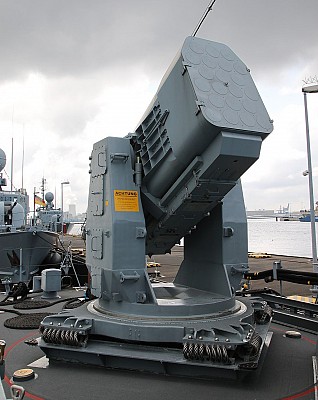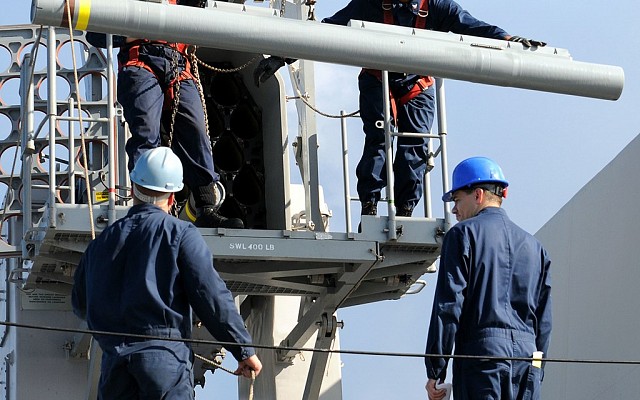RIM-116 RAM
Rolling Airframe Missile
Overview

RIM-116 RAM
A RIM-116 Rolling Airframe Missile being launched from a Mk 31 GMWS system on a San Antonio class landing platform dock in 2009
Source: US Navy -
© Public domain
2000 for Block 1
2015 for Block 2
Germany - Diehl BGT Defence
Germany - MBDA / Diehl BGT Defence
US$ 444.000 for Block 1 in 1999
US$ 998.000 in 2014
US$ 905.000 in 2021
Germany
Japan
Description
Introduction
The Rolling Airframe Missile is a modern era surface to air missile of US-German origin. Development started in the late Cold War era and was a joint USA and West German effort. The goal was to develop a point defense system against inbound anti-ship missiles which had greater performance and standoff range than gun-based systems. RAM was the first dedicated missile design for naval missile defense.
Design
The Rolling Airframe Missile itself is a unique combination of proven off-the-shelf components. The main body of the missile, including rocket motor and warhead, are from the AIM-9 Sidewinder short range air to air missiles. The infrared seeker comes from the Stinger man portable surface to air missile. Two radio antenna are fitted to the seeker head. These provide the ability for passive radar homing. Since these operate in a single plane, the missile needs to spin in order to determine the direction of the inbound anti-ship missile. This rolling of the airframe is what gives the RAM missile its name. Over time the missile saw minor and major improvements in several blocks.
Firepower
The RAM has a speed between Mach 2 and 3. Maximum effective range is about 9 km for early models and 15 km for Block 2 missiles. Although the RAM can reach several kilometers in altitude it is most likely to be employed against sea skimming missiles. An effectiveness of 95% has been derived from live fire tests. In practice the success rate will most likely depend on the target parameters, including target characteristics, saturation, weather conditions and countermeasures.
Guidance
The RAM uses a dual mode seeker. The passive radar homing guidance is used to steer the missile towards an inbound anti-ship missile. The infrared homing seeker has increased performance the closer it is to the target. This is used in the terminal stage. A laser proximity fuse detonates the blast-fragmentation warhead near the target missile. Guidance has been continuously improved over time. The infrared seeker has been updated to include the ultraviolet spectrum and later became an imaging infrared seeker. An infrared all the way guidance was also added to target inbound missiles that do not use active radar homing. The passive radar homing has been updated to function in ECCM conditions. A software update added the ability to target helicopters, aircraft and surface vessels. The latest update includes a datalink for communication between missiles in flight.
Platforms
The RAM is predominantly used in the Mk 31 Guided Missile Weapon System. This includes one or more 21-cell launchers and a central command post that is integrated with the ship's radar systems. In 2009 the SeaRAM became operational. This is a much simpler and more compact system that is based on Phalanx close-in weapon system. Classes of ships that have been fitted with RAM range from fast patrol boats to aircraft carriers. Frigates and destroyers are the most common types of ship to be fitted with RAM systems.
Users
The RAM was jointly developed by the United States and West Germany. These two nations are the early adopters and placed the most sizeable orders. About a dozen nations have adopted the RAM. These include NATO nations and various other nations around the world with close ties to the United States. RAM remains in production and is actively marketed and installed on new classes of ships.
Variants

RIM-116 RAM
A RIM-116 Rolling Airframe Missile being launched from a Mk 31 GMWS system on a Nimitz class aircraft carrier in 2016.
Source: US Navy -
© Public domain
List of RAM variants
Details
Launch platforms

Mk 31 GMWS
The Mk 31 GMWS is first and most common system used to launch the RIM-116 RAM missile. This system uses one or more 21-cell Mk 49 GMLS launchers and is connected to the ship's sensors and combat data management system.

RALS
The RAM Alternate Launching System (RALS) was developed for smaller vessels for which the entire Mk 31 GMWS was too large or expensive. This German/Danish development had a 10 missile capacity. It never reached operational state.

SeaRAM
The SeaRAM is a standalone launcher derived from the Mk 15 Phalanx close-in weapon system. SeaRAM holds a total of 11 RAM missiles ready to fire.
Media
Related articles

FIM-92 Stinger
The RIM-116 RAM uses the infrared seeker design from the FIM-92 Stinger man portable SAM system.



